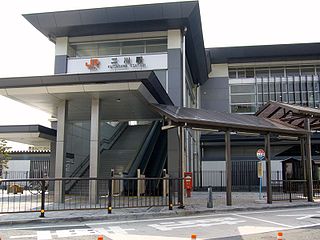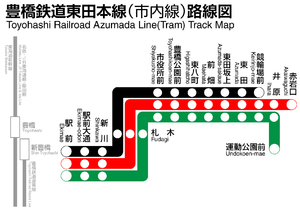
Toyohashi Station is an interchange railway station in Toyohashi, Aichi, Japan, operated by Central Japan Railway Company and the private railway operator Nagoya Railroad (Meitetsu).

The Uemachi Line is a tramway line of Hankai Tramway Co., Ltd. in Osaka, Japan.

Toyohashi is a city in Aichi Prefecture, Japan. As of 1 December 2019, the city had an estimated population of 377,453 in 160,516 households and a population density of 1,400 persons per km2. The total area of the city was 261.86 square kilometres (101.10 sq mi). By area, Toyohashi was Aichi Prefecture's second-largest city until March 31, 2005 when it was surpassed by the city of Toyota, which had merged with six peripheral municipalities.

The Toyamakō Line is a tram line operated by Toyama Chihō Railway in the city of Toyama, the capital of Toyama Prefecture. Trams commences at Toyamaeki, beneath Toyama Station, and travels north to Iwasehama in a town of the Toyama Port on Sea of Japan.

Tosaden Kōtsū (とさでん交通) is a transportation company in Kōchi, Kōchi, Japan. The public company operates tram and bus lines.

The Toyohashi Railroad is a private railroad company in Japan, and a subsidiary of the Meitetsu Group. The company or its lines are commonly known as Toyotetsu (豊鉄). The company operates the Atsumi Line train service on Atsumi Peninsula in Aichi Prefecture and a tram system in Toyohashi City, and has subsidiary operations involved in taxi and bus services.

The Toyama Chihō Railway is a transportation company in Toyama, Toyama Prefecture, Japan. The company is commonly known as Chitetsu (地鉄). The private company operates railway, tram, and bus services in the eastern part of the prefecture. It also operates as the agency of All Nippon Airways in Toyama area. The company has its root in Toyama Electric Railway founded in 1930. The current company was founded in 1943, when all the private and public operators of railway, tram, and bus lines in the prefecture were merged into one. In 1950, it founded Kaetsunō Railway, planning to build the railway line that links Toyama and Ishikawa. Chitetsu handed over its networks in the western part of Toyama Prefecture, although the plan never came into reality.

The Chikuhō Electric Railroad Line is a railway line in Fukuoka Prefecture, Japan, connecting Kurosaki-Ekimae in Kitakyushu with Chikuhō-Nōgata Station in Nōgata, operated by Chikuhō Electric Railroad. The line does not have an official name. The company and the line is also called Chikutetsu (筑鉄). The company is a subsidiary of Nishi-Nippon Railroad (Nishitetsu), founded in 1951. The line originally had a through service with the Nishitetsu Kitakyushu Line, a tram line closed in 2000. Because of this, the Chikutetsu Line only uses tram vehicles. However, the line is legally classified as a railway under Railway Business Act, not a tramway under Tram Act, and the line does not share any segments with public roads.

Futagawa Station is a railway station in the city of Toyohashi, Aichi Prefecture, Japan, operated by Central Japan Railway Company.

Funamachi Station is a railway station in the city of Toyohashi, Aichi Prefecture, Japan, operated by Central Japan Railway Company.

Shimoji Station is a railway station in the city of Toyohashi, Aichi Prefecture, Japan, operated by Central Japan Railway Company.

The Fukui Railway Fukubu Line is a 21.4 km railway line operated by Fukui Railway in Fukui Prefecture. The line runs from Echizen-Takefu Station in Echizen to Tawaramachi and Fukui-Ekimae stations in Fukui. Although it has its own right-of-way for most of the route, the Fukubu Line runs with traffic as a tram line past Fukui-Shin Station.

The Toyohashi Railroad Atsumi Line is a railway line in eastern Aichi Prefecture, Japan, operated by the private railway operator Toyohashi Railroad ("Toyotetsu"). The line runs from the centre of Toyohashi, traversing the centre of the Atsumi Peninsula, a largely rural district noted also for its hot spring resorts and marine sports as part of Mikawa Wan Quasi-National Park. The line is entirely within the cities of Toyohashi and Tahara.

Minami-Sakae Station is a railway station in the city of Toyohashi, Aichi Prefecture, Japan, operated by the Public–private partnership Toyohashi Railroad.

Aichidaigakumae Station is a railway station in the city of Toyohashi, Aichi Prefecture, Japan, operated by the Public–private partnership Toyohashi Railroad.

Yagyu-bashi Station is a railway station in the city of Toyohashi, Aichi Prefecture, Japan, operated by the Public–private partnership Toyohashi Railroad.

The Toyama City Tram Line of Toyama Chihō Railway, commonly referred to as 市電, is a narrow gauge tram system in Toyama, Japan. Its first operation was in 1912. It has 23 stations and runs 7.3 km.

The H100 series (H100形) is a Japanese diesel-electric multiple unit (DEMU) train type introduced by Hokkaido Railway Company to replace the ageing KiHa 40 series DMU cars. The trains are nicknamed "DECMO", standing for "Diesel Electric Car with MOtors". They commenced passenger operations in March 2020 on the Hakodate Main Line.

The Keisei 3100 series (京成3100形) is an electric multiple unit (EMU) train type operated by the private railway operator Keisei Electric Railway on Narita Sky Access Line services.























